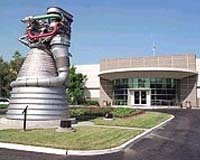 |
Stennis Space Center MS (SPX) Nov 12, 2010 NASA's John C. Stennis Space Center in Mississippi conducted a successful test firing Wednesday of the liquid-fuel AJ26 engine that will power the first stage of Orbital Sciences Corp.'s Taurus II space launch vehicle. Orbital and its engine supplier, Aerojet, test-fired the engine on Stennis' E-1 test stand. The test directly supports NASA's partnerships to enable commercial cargo flights to the International Space Station. The initial test, the first in a series of three firings, lasted 10 seconds and served as a short-duration readiness firing to verify AJ26 engine start and shutdown sequences, E-1 test stand operations, and ground-test engine controls. The test was conducted by a joint operations team comprised of Orbital, Aerojet and Stennis engineers, with Stennis employees serving as test conductors. The joint operations team and other NASA engineers will conduct an in-depth data review of all subsystems in preparation for a 50-second hot-fire acceptance test scheduled several weeks from now. A third hot-fire test at Stennis also is planned to verify tuning of engine control valves. "Congratulations to Orbital and Aerojet for successfully completing another major milestone," said Doug Cooke, associate administrator for the Exploration Systems Mission Directorate at NASA Headquarters in Washington. "This brings us one step closer to realizing NASA's goals for accessing low Earth orbit via commercial spacecraft." The AJ26 engine is designed to power the Taurus II space vehicle on flights to low Earth orbit. The NASA-Orbital partnership was formed under the agency's Commercial Orbital Transportation Services joint research and development project. The company is under contract with NASA to provide eight cargo missions to the space station through 2015. "With this first test, Stennis not only demonstrates its versatility and status as the nation's premiere rocket engine test facility, it also opens an exciting new chapter in the nation's space program," said Patrick Scheuermann, Stennis' center director. "We're proud to be partnering with Orbital to enable the wave of the future - commercial flights to space and eventual resupply of cargo to the International Space Station." In addition to the Orbital partnership, Stennis also conducts testing on Pratt and Whitney Rocketdyne's RS-68 rocket engine. The AJ26 is the first new engine in years to be tested at Stennis. Operators spent more than two years modifying the E-1 test stand in preparation. Work included construction of a 27-foot-deep flame deflector trench, major structural modifications and new fluid and gas delivery systems.
Share This Article With Planet Earth
Related Links Stennis Space Center Rocket Science News at Space-Travel.Com
 Rocketdyne To Perform Risk-Reduction Tests On 3GRB Engine
Rocketdyne To Perform Risk-Reduction Tests On 3GRB EngineCanoga Park, CA (SPX) Nov 12, 2010 The Air Force Research Laboratory (AFRL) has awarded Pratt and Whitney Rocketdyne a $2.35 million contract to perform risk-reduction tests on key components of the Third Generation Reusable Booster (3GRB) rocket engine design. The 3GRB is a technology demonstration program for future U.S. Air Force spaceflight missions. Pratt and Whitney Rocketdyne is a United Technologies Corp company. ... read more |
|
| The content herein, unless otherwise known to be public domain, are Copyright 1995-2010 - SpaceDaily. AFP and UPI Wire Stories are copyright Agence France-Presse and United Press International. ESA Portal Reports are copyright European Space Agency. All NASA sourced material is public domain. Additional copyrights may apply in whole or part to other bona fide parties. Advertising does not imply endorsement,agreement or approval of any opinions, statements or information provided by SpaceDaily on any Web page published or hosted by SpaceDaily. Privacy Statement |